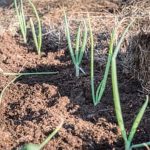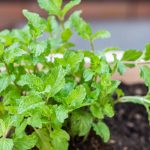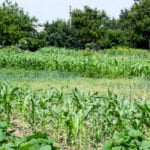The pH level of soil plays a crucial role in the growth and development of vegetables. It determines the availability of essential nutrients to plants and directly affects their overall health and productivity. Maintaining optimal pH levels is vital for ensuring that vegetable gardens thrive.
However, there are concerns about whether lime, a commonly used soil amendment, is safe for vegetable gardens. This article aims to explore the effects of lime on pH levels in vegetable gardens and provide valuable insights for gardeners seeking to make informed decisions.
In order to comprehend the impact of lime on vegetable gardens, it is essential to understand how pH levels influence plant growth and nutrient absorption. pH levels indicate whether a soil is acidic, neutral or alkaline, with values below 7 considered acidic and values above 7 considered alkaline.
Different varieties of vegetables have specific pH preferences, and maintaining the appropriate range facilitates nutrient availability. Additionally, imbalanced pH levels can lead to reduced nutrient uptake by plants, resulting in stunted growth or deficiencies.
Lime is a common substance used to adjust soil pH levels in vegetable gardens. It comes in various forms such as hydrated lime and dolomitic lime. When applied to soil, lime reacts chemically with organic matter and minerals present in the ground. This reaction leads to an increase in soil pH, making it less acidic and more alkaline. Understanding how lime affects soil chemistry provides valuable insights into its potential benefits for vegetable gardens.
Addressing concerns about using lime in vegetable gardens can help gardeners make informed decisions regarding their soil management practices. By exploring its effects on pH levels and understanding its chemical composition, we can better evaluate whether lime is safe for use in our vegetable beds.
With this knowledge in hand, we can then delve deeper into testing our soil’s pH level and learning about alternative methods for balancing soil acidity or alkalinity if desired outcomes cannot be achieved through lime application alone.
What is Lime and How Does it Affect pH Levels in Soil?
Lime is a common soil amendment used in vegetable gardens to adjust and regulate pH levels. It comes in various forms, including hydrated lime and dolomitic lime, which are often used interchangeably. Hydrated lime is made by heating limestone to release carbon dioxide, while dolomitic lime contains magnesium in addition to calcium. The chemical composition of lime allows it to react with soil and raise the pH levels.
When lime is added to soil, it undergoes a chemical reaction known as “liming.” This process involves the release of hydroxide ions that bind with hydrogen ions in the soil, effectively neutralizing the acidity and raising the pH level. As a result, lime helps create a more balanced and optimal environment for vegetable plants.
The impact of lime on pH levels in soil is crucial for vegetable gardens because different plants have specific pH requirements for optimal growth and nutrient absorption. Most vegetables thrive in slightly acidic to neutral soils, with a recommended pH range of 6.0-7.0.
When the soil becomes too acidic (below 6.0), essential nutrients like nitrogen, phosphorus, and potassium cannot be efficiently absorbed by plant roots. By adding lime to raise the pH level within the recommended range, gardeners can ensure that their vegetables can access these vital nutrients for healthy growth.
How Does Lime Affect pH Levels in Soil?
- Lime reacts with hydrogen ions in the soil through liming process
- Hydrogen ions are replaced by hydroxide ions released from lime
- Hydroxide ions bind with hydrogen ions to neutralize acidity
- pH level increases as acidity decreases
Benefits of Using Lime in Vegetable Gardens
- Neutralizes acidic soils: Lime raises the pH level of acidic soils, creating a more favorable environment for vegetable plants.
- Enhances nutrient availability: By increasing soil pH, lime enhances the availability and uptake of essential nutrients like nitrogen, phosphorus, and potassium.
- Reduces certain plant diseases: Lime can help control diseases caused by acid-loving pathogens. It creates an environment where detrimental microorganisms find it challenging to thrive.
- Improves soil structure: Lime promotes better aggregation of soil particles and improves overall soil structure, allowing for better root penetration and water infiltration.
Knowing how lime affects pH levels in the soil is vital for maintaining healthy vegetable gardens. It allows gardeners to adjust the acidity levels according to their plants’ specific requirements. In the next section, we will discuss how to determine the pH level of your vegetable garden and what the ideal range is for optimal nutrient availability.
Determining the pH Level of Your Vegetable Garden
In order to maintain optimal pH levels in your vegetable garden, it is important to regularly test and monitor the acidity or alkalinity of the soil. This can be done easily with the help of pH test kits or meters. Here are step-by-step instructions on how to determine the pH level of your vegetable garden:
- Collect soil samples: Take multiple soil samples from different areas of your vegetable garden using a trowel or soil sampling tool. Make sure to collect samples from different depths, ranging from the surface to about 6 inches deep.
- Prepare the soil samples: Remove any debris such as leaves or rocks from each soil sample. Mix the samples together in a clean container, breaking up any clumps and ensuring a well-mixed representation of your garden’s soil.
- Test the pH level: Follow the instructions provided with your pH test kit or meter to measure the pH level of your soil mixture. Typically, this involves adding a solution or inserting a probe into the soil sample and waiting for a color change or digital readout.
- Interpret the results: After testing, compare your pH reading with the ideal range for vegetable gardens, which is generally around 6.0 to 7.0 for most vegetables. A lower reading indicates acidic soil, while a higher reading indicates alkaline soil.
Understanding and monitoring your garden’s pH levels is crucial because it directly affects nutrient availability in the soil. When pH levels are too high or too low, certain nutrients may become locked up in the soil and unavailable for plant uptake, leading to stunted growth and nutrient deficiencies.
To maintain optimal plant health and maximize growth potential, it is important to address imbalanced pH levels in your vegetable garden through corrective measures such as applying lime when necessary. By regularly testing your garden’s pH levels, you can make informed decisions about adjusting them and ensure that your plants have the necessary nutrients for successful growth.
Benefits of Using Lime in Vegetable Gardens
Neutralizing acidic soil
One of the main benefits of using lime in vegetable gardens is its ability to neutralize acidic soil. Acidic soil, typically with pH levels below 6.0, can inhibit the growth and development of many vegetables. Lime contains calcium carbonate, which reacts with the acidic elements in soil, raising the pH level and creating a more favorable environment for plant growth. By neutralizing the acidity, lime helps to unlock essential nutrients that may have been previously unavailable to plants.
Enhancing nutrient availability and uptake
In addition to neutralizing acidity, lime also plays a crucial role in enhancing nutrient availability and uptake for vegetable plants. When soil becomes too acidic, certain nutrients like phosphorus, potassium, and magnesium become less accessible to plants. However, by increasing the pH level through lime application, these nutrients become more readily available for plant absorption. This improved nutrient availability allows vegetable crops to grow healthier and more vigorously.
Reducing plant diseases and improving soil structure
Another benefit of using lime in vegetable gardens is its ability to reduce certain plant diseases while simultaneously improving overall soil structure. Many harmful pathogens thrive in acidic environments; therefore, by raising the pH level with lime application, these pathogens are less likely to survive and harm vegetable crops. Additionally, lime helps to improve soil structure by increasing the aggregation of soil particles. This improved structure allows for better water drainage and root penetration while preventing compaction.
It is important to note that while lime offers numerous benefits for vegetable gardens, it should be used judiciously according to your specific soil’s needs. Overuse or improper application of lime can lead to negative consequences such as excessively high pH levels or imbalanced nutrient ratios. Therefore, it is recommended to test your garden’s pH regularly and consult with horticulture experts or local extension services for personalized recommendations before applying lime.
Lime Application Guidelines for Vegetable Gardens
Step-by-Step Instructions for Applying Lime to Vegetable Gardens
When it comes to applying lime to your vegetable garden, it is essential to follow proper guidelines to ensure optimal results. Here are some step-by-step instructions to help you apply lime effectively:
- Test the Soil pH: Before applying lime, it is crucial to determine the current pH level of your vegetable garden soil. You can use pH test kits or meters that are available at most gardening centers. Follow the instructions provided with the test kit or meter to obtain an accurate reading.
- Determine Lime Quantity: Once you have established the soil’s pH level, you need to calculate the quantity of lime required for your garden. Different types of soil require different amounts of lime for pH adjustment. Sandy soils usually require less lime compared to clay soils. Refer to a reliable source or consult with a local horticulture expert for specific recommendations based on your soil type and pH levels.
- Apply Lime Evenly: After determining the appropriate quantity of lime, spread it evenly across your vegetable garden using a spreader or by hand if you have a small area. It is essential to distribute the lime uniformly so that all parts of the garden receive equal treatment.
- Incorporate Lime into the Soil: Once you have applied lime, use a rake or garden fork to gently mix it into the top few inches of soil. This process helps ensure that the lime is evenly distributed throughout the root zone where plants can effectively utilize it.
- Monitor and Reapply as Needed: After applying lime, monitor your vegetable garden’s pH levels regularly using test kits or meters. Keep in mind that adjusting soil pH is not an immediate process; it may take several months for significant changes to occur. If necessary, reapply lime based on your test results and any specific recommendations from experts.
Timing and Frequency of Lime Application
The timing of lime application is crucial for its effectiveness in vegetable gardens. It is generally recommended to apply lime during the fall or winter months when the soil is dormant and not being actively used for planting. By applying lime during this time, it has ample opportunity to react with the soil and adjust pH levels before the next growing season.
The frequency of lime application depends on the initial pH level of your vegetable garden soil and your desired target pH range. In most cases, a single application of lime can have a lasting impact for several years. However, if your soil’s pH levels are extremely acidic or alkaline, you may need to reapply lime more frequently to maintain optimal pH levels.
Remember that excessive lime application can be harmful rather than beneficial. Over-liming can lead to nutrient imbalances and hinder plant growth. Therefore, it is essential to monitor your soil’s pH levels regularly and take appropriate action only when necessary.
Potential Risks and Precautions when Using Lime in Vegetable Gardens
When using lime in vegetable gardens, there are potential risks that gardeners should be aware of and precautions that should be taken to ensure the safety and health of plants and soil organisms.
One of the potential risks associated with lime application is over-liming. Applying too much lime can lead to excessively high pH levels, which can be detrimental to vegetable plants. High pH levels can cause nutrient imbalances, making it difficult for plants to absorb essential minerals. Additionally, certain vegetables, such as blueberries and potatoes, prefer acidic soil conditions and may suffer if the pH becomes too alkaline.
To mitigate the risk of over-liming, it is important to test the pH levels of your soil before applying lime. This will help determine whether or not lime is necessary and how much should be applied. It is recommended to follow the guidelines provided by reliable sources or consult with a local agricultural extension office for specific recommendations based on your soil type and vegetable plant preferences.
Another precaution when using lime in vegetable gardens is considering its potential impact on beneficial soil organisms. Lime can temporarily disturb the balance of microorganisms in the soil, particularly those that prefer acidic conditions. This disruption may affect nutrient cycling and overall soil health.
To minimize this impact, gardeners can consider using organic materials alongside lime to promote a diverse microbiome in the soil. Amendments like compost or well-aged manure can help replenish beneficial organisms affected by lime application.
Overall, while there are potential risks associated with using lime in vegetable gardens, taking precautions such as testing pH levels and considering its impact on soil organisms can help mitigate these risks. By practicing safe and informed use of lime, gardeners can enjoy the benefits it offers in terms of balancing pH levels, improving nutrient availability, and creating a healthy growing environment for their vegetable plants.
| Potential Risks | Precautions |
|---|---|
| Over-liming | – Test soil pH levels before applying lime
|
| Impact on soil organisms | – Use organic materials alongside lime to replenish beneficial organisms
|
Alternative Methods for Balancing Soil pH in Vegetable Gardens
There are several alternative methods available for organic gardeners to adjust soil pH and maintain ideal conditions for their vegetable gardens. While lime is commonly used to increase soil pH, there are organic materials that can be used as effective alternatives. These alternatives include compost, peat moss, and cottonseed meal. Understanding the pros and cons of each method will help gardeners make informed decisions based on their specific needs.
Compost is a popular choice among organic gardeners for balancing soil pH levels. It is a nutrient-rich material derived from the decomposition of organic matter such as food scraps, leaves, and grass clippings. Compost has a natural buffering capacity that helps stabilize soil pH over time. It can slightly increase or decrease the pH depending on the initial acidity or alkalinity of the soil. Additionally, compost improves soil structure, enhances water retention, and provides essential nutrients to plants.
Peat moss is another effective alternative for adjusting soil pH in vegetable gardens. It is a partially decomposed plant material harvested from bogs during peatland restoration or timber harvesting processes. Peat moss has an acidic nature, so it is beneficial when trying to lower the pH of alkaline soils. It also improves moisture retention in sandy soils and promotes nutrient availability for plants. However, it should be used with caution as excessive use can lead to overly acidic conditions.
Cottonseed meal is a natural byproduct of oil extraction from cotton seeds and serves as an organic fertilizer with pH balancing properties. It tends to reduce high acidity in soils due to its alkaline nature while providing essential nutrients like nitrogen, phosphorus, and potassium.
This makes it an excellent choice when adjusting soil pH in vegetable gardens where concurrent fertilization is needed. However, it’s important to note that cottonseed meal should not be used excessively as it may increase salt content in the soil.
| Alternative Method | Pros | Cons |
|---|---|---|
| Compost | – Natural buffering capacity
| – Gradual pH adjustment
|
| Peat Moss | – Acidic nature helps lower pH in alkaline soils
| – Excessive use can lead to overly acidic conditions
|
| Cottonseed Meal | – Alkaline nature helps reduce high acidity
| – Excessive use may increase salt content.
|
Conclusion
In conclusion, understanding and maintaining optimal pH levels in your vegetable garden is crucial for the success of your plants. pH levels play a significant role in nutrient absorption and overall plant growth. With proper knowledge and monitoring of pH levels, you can ensure that your vegetables thrive and produce a bountiful harvest.
Lime is a commonly used amendment to adjust soil pH levels. It can effectively neutralize acidic soil and enhance nutrient availability for plants. By increasing soil pH, lime helps create an environment that allows vegetables to absorb nutrients more efficiently, leading to improved growth and productivity.
However, it is important to exercise caution when using lime in your vegetable garden. Over-liming can have detrimental effects on both the plants and the beneficial organisms in the soil. It is essential to follow guidelines for application and determine the appropriate amount of lime based on your soil type and pH levels.
In making informed decisions for your vegetable garden, consider alternative methods for balancing soil pH as well. Organic materials like compost, peat moss, or cottonseed meal can be effective in adjusting pH levels while providing additional organic matter to improve soil structure.
By knowing the importance of pH levels, understanding how lime affects soil pH, testing your soil regularly, following guidelines for lime application, and considering alternative methods, you are well-equipped to make informed decisions about using lime in your vegetable garden. Ultimately, with proper care and attention to pH levels, you can create an optimal environment for your vegetables to flourish and enjoy a successful growing season.
Frequently Asked Questions
Which vegetables do not like lime?
Some vegetables do not thrive in acidic soil conditions, so they do not like lime. This includes crops like potatoes, sweet potatoes, and peppers. These vegetables prefer a slightly acidic pH level for optimal growth and nutrient absorption.
Adding lime to the soil can raise the pH, making it more alkaline, which may not be favorable for these particular vegetables. It is important to check the specific pH requirements of each vegetable before applying lime to the garden.
What happens if you put too much lime in your vegetable garden?
If you put too much lime in your vegetable garden, it can lead to excessively alkaline soil conditions. This high alkalinity can interfere with the availability of essential nutrients for your plants.
The excessive levels of lime can cause certain elements like iron, manganese, and phosphorus to become less available in the soil, leading to nutrient deficiencies in your vegetables. Additionally, pH extremes can affect beneficial soil organisms and hinder their ability to perform important functions such as nutrient cycling.
How do you use lime in a vegetable garden?
Lime is commonly used in a vegetable garden to adjust soil pH levels and provide essential nutrients such as calcium and magnesium. Before using lime, it is important to test the soil’s acidity or alkalinity using a pH test kit or sending a sample for laboratory analysis. Based on the results, you can determine whether your soil requires lime for pH adjustment or not.
Lime is typically added to acidic soils (low pH) to raise the pH level towards neutrality (pH 7). It may be applied by spreading it evenly over the garden bed and then incorporating it into the top few inches of soil with a rake or turned under during cultivation. The amount of lime required varies depending on the type of crop being grown and its specific pH preferences; therefore, it is essential to follow recommended application rates provided by local agricultural extension services or gardening resources that take into account regional factors like climate and native soil characteristics.

If you’re looking to get into vegetable gardening, or are just looking for some tips on how to make your current garden better, then you’ve come to the right place! My name is Ethel and I have been gardening for years. In this blog, I’m going to share with you some of my best tips on how to create a successful vegetable garden.





